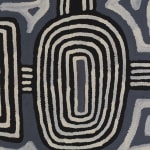
Ronnie Tjampitjinpa, Tingari Ceremonies at the Waterhole Site of Pinari, 1997
Photo: Courtesy of D’Lan Contemporary

(detail) Ronnie Tjampitjinpa, Tingari Ceremonies at the Waterhole Site of Pinari, 1997
Photo: Courtesy of D’Lan Contemporary

(detail) Ronnie Tjampitjinpa, Tingari Ceremonies at the Waterhole Site of Pinari, 1997
Photo: Courtesy of D’Lan Contemporary

(detail) Ronnie Tjampitjinpa, Tingari Ceremonies at the Waterhole Site of Pinari, 1997
Photo: Courtesy of D’Lan Contemporary

(detail) Ronnie Tjampitjinpa, Tingari Ceremonies at the Waterhole Site of Pinari, 1997
Photo: Courtesy of D’Lan Contemporary
Ronnie Tjampitjinpa Pintupi, Western Desert region, circa 1943-2023
Further images
Provenance
The Artist, painted at Kintore, Northern Territory
Papunya Tula Artists, Alice Springs, cat. no. RT970178
Gallery Gabrielle Pizzi, Melbourne
Private Collection, United States, acquired from the above
Important Aboriginal and Oceanic Art, Deutscher and Hackett, Melbourne, 24 March 2010, lot 96
Private Collection, Brisbane, acquired from the above
D'Lan Contemporary, Melbourne
Collection of Steve Martin & Anne Stringfield, New York
Exhibitions
Significant 2024, D'Lan Contemporary, Melbourne, 30 May 2024 – 12 July 2024
Literature
Vanessa Merlino and Isabella Wadley, Significant 2024, Melbourne, D'Lan Contemporary, 2024, p. 56-57 (illus.)This painting depicts body paint designs associated with Tingari Ceremonies at the soakage water site of Pinari, north of the Kintore Community. In mythological times a large number of Tingari Men travelled through this site during their journey further east.
Since events associated with the Tingari Cycle are of a secret nature no further detail was given. Generally, the Tingari are a group of mythical characters of the Dreaming who travelled over vast stretches of the country, performing rituals and creating and shaping particular sites. The Tingari Men were usually followed by Tingari Women and accompanied by novices and their travels and adventures are enshrined in a number of song cycles. These mythologies form part of the teachings of the post initiatory youths today as well as providing explanations for contemporary customs. — Papunya Tula Artists






